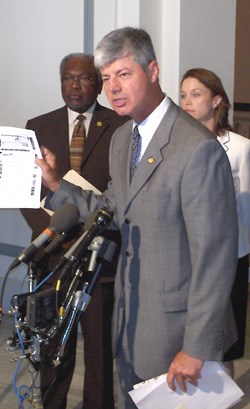NEWS RELEASE
CONGRESSMAN BART STUPAK
1ST CONGRESSIONAL DISTRICT OF MICHIGAN
*********************** Stupak blasts Rogers' food labelling bill
Offers motion to protect consumers from deceptively treated meat
WASHINGTON - Today, as the U.S. House of Representatives considered the National Uniformity for Food Act of 2005 authored by Congressman Mike Rogers (R-MI), an amendment offered by Congressman Bart Stupak (D-MI) to allow states to notify consumers about carbon monoxide treated meat was defeated on a mostly party line vote.
Carbon monoxide is used to deceive consumers about the freshness of meat and seafood.
"Many Americans were appalled to learn last month that the meat they purchase may not be as fresh as it appears," Stupak said. "Reports drew attention to a new practice that allows carbon monoxide to be included in meat packaging to change the color to a bright red that lasts for weeks or even months, even when un-refrigerated. This practice is consumer deception at best, and at worst it masks deadly pathogens, such as E. coli and salmonella."
Stupak said that consumers have no way of knowing whether meat and seafood has been packed in carbon monoxide if the Rogers bill becomes law.
Congressman Stupak's motion would have allowed states to label meat and seafood packaged in carbon monoxide.
The Food and Drug Administration (FDA) recently approved this new procedure without public comment, independent studies, or research.
"The FDA shouldn't be the only voice in food safety," Stupak said. "Food safety has largely been a matter of state law for well more then a century. State and local agencies perform more than 80 percent of food safety work, with federal agencies often seeking their assistance. We need all levels of government to work together to provide consumers with safe food on their dinner table. State and local governments are often the first line of defense when problems arise so it is critical their rights are not bypassed."
The Rogers bill would strip state governments of the ability to protect their residents through state laws and regulations relating to the safety of food and food packaging.
Stupak's amendment to allow labeling of meat treated with carbon monoxide was blocked by Republicans in the Rules Committee from coming to the House floor for a vote.
In an attempt to allow Members of Congress to still vote on the issue, the Democrats offered Stupak's amendment as their Motion to Recommit - a procedural move which would have sent the bill back to committee with instructions to include Stupak's carbon monoxide labeling provision.
The vote failed on a largely party line vote of 170 to 254.
Other important consumer warnings dealing with mercury in fish, arsenic in drinking water and lead in cans are examples of additional states' food requirements that would be removed under this bill.
The bill is opposed by state food and drug officials, 39 state attorneys general, and numerous consumer protection organizations.
**********************
